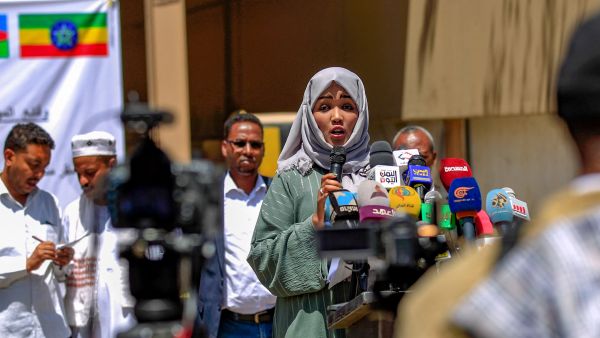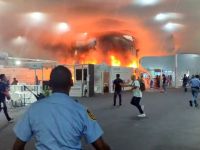The UN envoy for Yemen, Martin Griffiths has demanded an enquiry after at least 44 African migrants rounded up for fear they were spreading the coronavirus have perished when Iran-backed Houthi forces fired on a building and set it ablaze.
Griffiths told the Security Council yesterday “there must be an independent investigation into the cause of the fire”. He added that the “extraordinary, horrific fire” had reminded the world “of the plight of the migrant community”.
Survivors and local Eritrean and Ethiopian community leaders claim the 9 March blaze in the overcrowded detention centre in Yemen’s rebel-held capital Sana’a broke out when guards fired tear gas into a crowded hangar trying to end a protest by the migrants inside
Outcry after migrants burnt to death in Houthi detention camp | https://t.co/JTI7WmdiU4
— Abeer Allam عبير (@abeerallamj) March 17, 2021
According to the International Organisation for Migration (IOM) some 900 migrants, most of them from Ethiopia, were detained at the Passports and Naturalisation Authority complex, including 350 inside the hangar.
Sanaa Mohammed Nour, head of the Eritrean migrant community in Sanaa, said that along with the 44 killed migrants, more than 180 migrants were injured.
She feared the final death toll could be much higher. At least eight people were pronounced dead on Sunday, but the IOM was being denied access to injured migrants at hospitals and could not confirm the final death toll.
Human Rights Watch said Houthi forces had locked the migrants in the building after a “skirmish” between guards and detainees.
Citing migrant witnesses, HRW said the militants had then launched two unidentified projectiles into the building.
“The migrants said the first projectile produced a lot of smoke and made their eyes water and sting. The second, which the migrants called a ‘bomb’, exploded loudly and started a fire” .
A video published by HRW showed security forces walking among survivors outside the facility as the fire raged inside, sending black smoke billowing into the sky.
“I don’t have the words to express what it was like — (the projectiles) exploded and there was so much smoke and then there was a fire that spread,” HRW quoted a 20-year-old migrant as saying.”I was terrified, I felt like my mind was blocked with smoke.”
An Ethiopian survivor detained by the Houthi rebels late last year, said dozens were trapped and unable to escape the blaze.
“I saw bodies being burned in the hangar,” said the man who was later released from detention. He spoke on condition of anonymity for fear of reprisals.
The Iran-backed Houthi rebels, who control the capital and most of Yemen’s north, did not reveal the cause of the fire, acknowledge any protest nor give a final casualty toll. The Houthis also prevented the IOM from reaching injured migrants at hospitals, the agency said.
The rebels use the facility to detain African migrants who cross Yemen in hope of reaching wealthy Gulf Arab countries. Hundreds of them had gone on a hunger strike earlier this month in protest at alleged ill-treatment and abuses.
Around 350 of the migrants had been moved out of the main building because of overcrowding and were held in the hangar. On the morning of the blaze, they launched a protest against their conditions, shouting and banging on doors, three survivors and the IOM official said.
The guards were unable to control them so an anti-riot squad was called in. Scuffles broke out and the security forces fired tear gas and shot into the air. A Yemeni rights group, Mwatana for Human Rights, cited witnesses saying the Houthis also fired unidentified projectiles through the windows into the hangar. The group said that these projectiles caused a fire, which quickly spread.
At some point, the migrants managed to break down the doors and some escaped but were quickly recaptured, the survivors said.
A spokesman for the Houthis has since been refusing to take any calls
The IOM official said the death toll could have been even higher as another 200 migrants were expected to arrive at the Sanaa facility on that day. That group was rerouted elsewhere because of the fire, the official said.
The migrants are typically captured in the northern province of Sadaa, which borders Saudi Arabia. According to the IOM official, those detained are then taken to Sanaa, where they are held by the rebels until they each pay at least 1,000 Saudi rials to be freed. Since last year, 15,000 detained migrants were forcibly taken to southern Yemen.
Following the fire, the rest of the migrants were transported to southern provinces, controlled by the internationally recognised government, with the IOM believing some of the injured were also among them.
The Saudi-led coalition fighting the Houthi group in Yemen said it had facilitated the evacuation by air of 160 African immigrants, under the supervision of the United Nations, Saudi state television reported on Tuesday.
Continued flow
Amnesty International has also called for an independent investigation and for the UN to refer the situation in Yemen to the International Criminal Court.
The Houthis cordoned off hospitals and blocked access to injured migrants. “We are facing challenges accessing the injured due to an increased security presence in the hospitals,” said Carmela Godeau, IOM’s regional director for the Middle East and North Africa.
Dozens of migrants have attempted over the past two days to stage a protest outside a UN building in Sana’a, but the rebels dispersed them, Mwatana for Human Rights said.
“This fire is a horrific addition to the long list of violations migrants and refugees have faced in Yemen during this war and a horrific addition to the long list of violations” by the Houthis, said Radhya al-Mwtawakel, head of the group.
After the deadly blaze, the Houthis set free at least 200 detained migrants, according to Nour from Eritrea and Ramadan Ahmed Youssef, a leading figure in Yemen from Oromo, Ethiopia’s largest ethnic group.
Despite its six-year civil war, Yemen remains a transit point for tens of thousands of African migrants desperate to find jobs as housekeepers, servants and construction workers in Saudi Arabia.
Some 138,000 migrants embarked on the arduous journey from the Horn of Africa to Yemen in 2019, but this number decreased drastically to 37,000 last year because of the coronavirus pandemic. Over 2,500 migrants reached Yemen from Djibouti in January, according to IOM.
Those migrants are vulnerable to abuse by armed traffickers, many connected to armed groups involved in the war. According to the IOM, earlier this month, at least 20 migrants died after smugglers threw 80 overboard during a voyage from Djibouti in East Africa to Yemen.
This article has been adapted from its original source.








